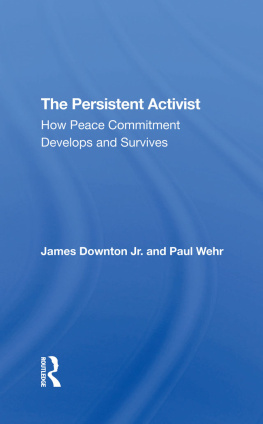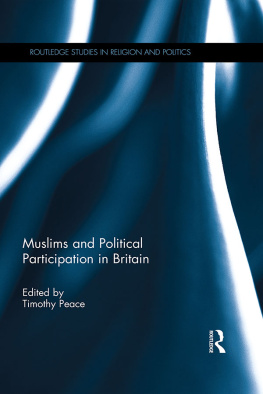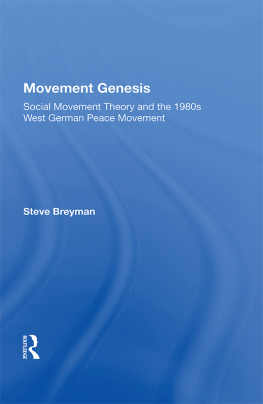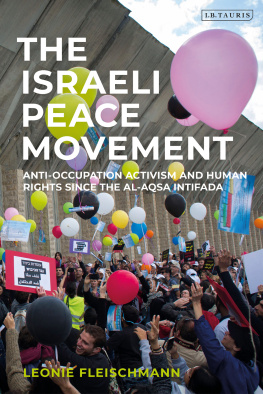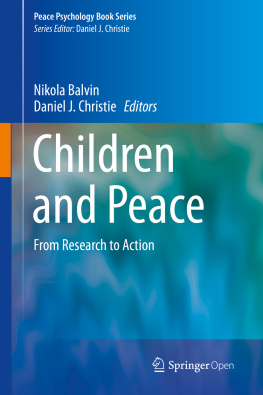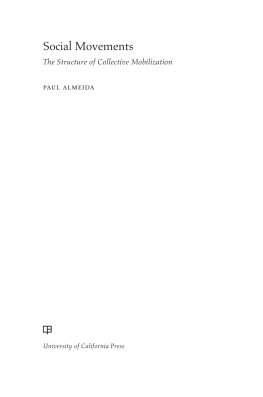The Persistent Activist
The Persistent Activist
How Peace Commitment Develops and Survives
James Downton Jr.
Paul Wehr
First published 1997 by Westview Press, Inc.
Published 2019 by Routledge
52 Vanderbilt Avenue, New York, NY 10017
2 Park Square, Milton Park, Abingdon, Oxon OX14 4RN
Routledge is an imprint of the Taylor & Francis Group, an informa business
Copyright 1997 Taylor & Francis
All rights reserved. No part of this book may be reprinted or reproduced or utilised in any form or by any electronic, mechanical, or other means, now known or hereafter invented, including photocopying and recording, or in any information storage or retrieval system, without permission in writing from the publishers.
Notice:
Product or corporate names may be trademarks or registered trademarks, and are used only for identification and explanation without intent to infringe.
Library of Congress Cataloging-in-Publication Data
Downton, James V.
The persistent activist: how peace commitment develops and survives / James Downton, Jr. and Paul Wehr.
p. cm.
Includes bibliographical references and index.
ISBN 0-8133-8139-8 (hc.) ISBN 0-8133-2999-X (pbk.)
1. Peace. 2. Peace movements. 3. Pacifists. I. Wehr, Paul Ernest, 1937- . II. Title.
JX1953.3.D65 1997
327.1'72dc21
96-53176
CIP
ISBN 13: 978-0-367-29477-9 (hbk)
We dedicate this hook to persistent peace and social justice activists everywhere, and especially to Anice Swift and Alex Mayer, two activists who inspired others through their exemplary peacemaking.
We are living at an unusual historical moment. A long period of cold war has given way to an uneasy peace of great political and economic uncertainty, The pattern of global politics looks quite different than it did a decade ago when the superpowers cast a threatening shadow of nuclear war over the political landscape. Though the structures of authority within and between nations are currently being rearranged, there is no assurance of peace and no reason to think that popular challenges to governments will subside in the future. Protest movements operating outside of normal politics will continue to be a major force for change as well as a constraint on those who govern.
We are also at a crucial point in our understanding of how social movements emerge, function, and decline. A cycle of protest lasting more than three decades has produced significant new analytical and experiential knowledge in the field of collective action. A large portion of citizens in the U.S. has now participated in protest politics and much scholarly work has been done to analyze and explain it. Unfortunately, social activists and collective action researchers have rarely worked together to produce knowledge that may be useful to movements. We feel that such collaboration is long overdue. We hope this book will encourage it.
We will be examining an aspect of collective action where an exchange between activist and researcher could be particularly useful. Maintaining participation in a social movement is of special interest to the leaders of movement organizations and to those who study them. Recruiting, then keeping, participants is particularly difficult for movements like the peace movement where the personal interests of peace workers are not consistently threatened and the public good they seek offers them little material reward. For instance, how does the peace movement maintain its vitality during inter-war periods when the public's interest in peace issues is low? How does it retain the commitment of its members and especially that small cadre of activists who keep it alive? How do those caretakers of the movement keep themselves going over the long term?
This study explores the movement experience of thirty Colorado peace activists, whose names we have changed to conceal their identities. What they teach us about movement participation should feed back into the peace movement to make it stronger and more effective. We have reviewed the research on movement participation, located our study within it, and developed a theory of sustained commitment as a possible contribution to collective action theory. Hoping to serve the activist and scholarly communities, we wanted to produce knowledge of both practical and theoretical value.
Activist and scholar alike may notice a common thread in the stories of these peace activists, which is that peace action evolves into an ethical career that is inseparable from personal identity and day-to-day life. Were we to discover that the commitments of participants in other movements develop and survive in ways similar to these peacemakers, we would be a step closer to a more general theory of persistent activism.
James Downton Jr.
Paul Wehr
This study represents the contributions of many people. Our thirty respondents revealed to us invaluable knowledge of how and why people work for change through social movements. We are deeply grateful to them for sharing their lives with us. We also want to give special thanks to Mary Downton, who read the manuscript carefully and offered useful suggestions to improve it; to Ann Underwood, who transcribed the interviews; to Jan Buhrmann, who prepared the manuscript for publication; and to Guy Burgess for his help with the graphics. We also want to thank the University of Colorado's Council on Research and Creative Work and the Department of Sociology for providing funds for various stages of the project. Finally, we want to acknowledge each other, for the patience, good humor, and openness to change that emerged over the course of the project. Ours was an equal undertaking, which is why we are listed alphabetically as co-authors. It is no small achievement to emerge from such an enterprise with a stronger friendship and greater mutual respect.
J.D.
P.W.
1
Peace Action
Peace activism can be a fleeting involvement on behalf of a single issue or a way of life. Activists know that it is a hard life of struggle and disappointments and a good life of meaning and community. Among those who become involved, only a hard core of people remain committed over the long term. They are the unwavering few who have made life careers out of nonviolent action and community organizing. This is a study of those persistere, people who have dedicated their lives to creating peace and social justice in the world. How they have maintained their commitment in the face of great odds and many disappointments is the interesting question we address.
Social movements are organized attempts by citizens to change the policies or structures of government when conventional means for attaining those ends have failed. The contemporary peace movement in the U.S. developed over the decades of the 1960s, 1970s, and 1980s to pressure the government to end the Cold War with the Soviet Union, to change its policies in Vietnam and Latin America, and to alter its domestic policy so that the issues of poverty and political inequality could be more forcefully addressed. The broad goals of the peace movement include peace between nations and an end to violence, a more equitable distribution of economic and political resources within and between nations, and an appreciation for diversity of gender, race, and culture.
Inspired by the examples of Gandhi and Martin Luther King, Jr., the movement uses nonviolent methods to achieve those goals. It uses conventional means, such as lobbying legislators to force a change in policy or educating the public about peace issues to change public opinion. Often it applies unconventional nonviolent direct action such as civil disobedience to disrupt or shut down governmental operations. The movement attracts a variety of people, from radicals who want sweeping changes of the political system to people with more moderate views who are content to work within the system to change it. The movement includes large national organizations devoted to peace action, although its greatest strength lies in the energy of the many activists who work within small local groups to plan and carry out projects of peaceful change.

